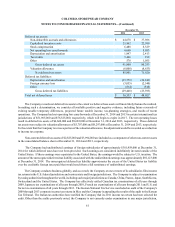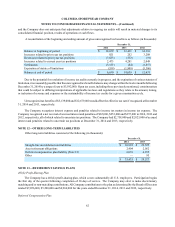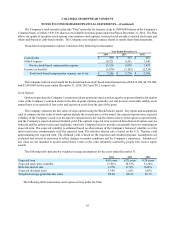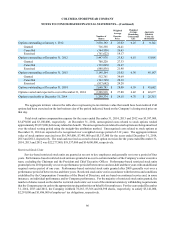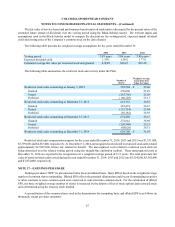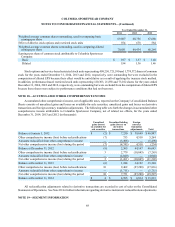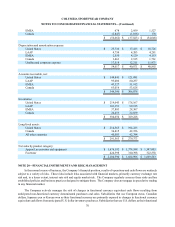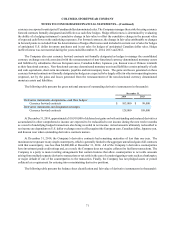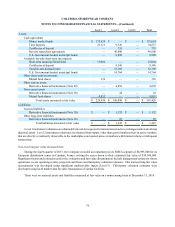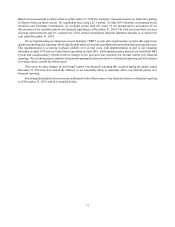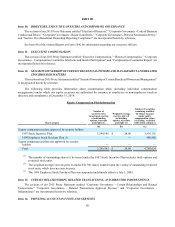Columbia Sportswear 2014 Annual Report Download - page 75
Download and view the complete annual report
Please find page 75 of the 2014 Columbia Sportswear annual report below. You can navigate through the pages in the report by either clicking on the pages listed below, or by using the keyword search tool below to find specific information within the annual report.
COLUMBIA SPORTSWEAR COMPANY
NOTES TO CONSOLIDATED FINANCIAL STATEMENTS—(Continued)
71
currency are exposed to anticipated Canadian dollar denominated sales. The Company manages these risks by using currency
forward contracts formally designated and effective as cash flow hedges. Hedge effectiveness is determined by evaluating
the ability of a hedging instrument’s cumulative change in fair value to offset the cumulative change in the present value
of expected cash flows on the underlying exposures. For forward contracts, the change in fair value attributable to changes
in forward points is excluded from the determination of hedge effectiveness and included in current cost of sales for hedges
of anticipated U.S. dollar inventory purchases and in net sales for hedges of anticipated Canadian dollar sales. Hedge
ineffectiveness was not material during the years ended December 31, 2014, 2013 and 2012.
The Company also uses currency forward contracts not formally designated as hedges to manage the consolidated
currency exchange rate risk associated with the remeasurement of non-functional currency denominated monetary assets
and liabilities by subsidiaries that use European euros, Canadian dollars, Japanese yen, Korean won or Chinese renminbi
as their functional currency. Non-functional currency denominated monetary assets and liabilities consist primarily of cash
and cash equivalents, short-term investments, payables and intercompany loans. The gains and losses generated on these
currency forward contracts not formally designated as hedges are expected to be largely offset in other non-operating income
(expense), net by the gains and losses generated from the remeasurement of the non-functional currency denominated
monetary assets and liabilities.
The following table presents the gross notional amount of outstanding derivative instruments (in thousands):
December 31,
2014 2013
Derivative instruments designated as cash flow hedges:
Currency forward contracts $ 103,000 $ 99,000
Derivative instruments not designated as hedges:
Currency forward contracts 128,000 109,000
At December 31, 2014, approximately $10,918,000 of deferred net gains on both outstanding and matured derivatives
accumulated in other comprehensive income are expected to be reclassified to net income during the next twelve months
as a result of underlying hedged transactions also being recorded in net income. Actual amounts ultimately reclassified to
net income are dependent on U.S. dollar exchange rates in effect against the European euro, Canadian dollar, Japanese yen,
and Korean won when outstanding derivative contracts mature.
At December 31, 2014, the Company’s derivative contracts had remaining maturities of less than one year. The
maximum net exposure to any single counterparty, which is generally limited to the aggregate unrealized gain of all contracts
with that counterparty, was less than $4,000,000 at December 31, 2014. All of the Company’s derivative counterparties
have investment grade credit ratings and, as a result, the Company does not require collateral to facilitate transactions. The
Company is a party to master netting arrangements that contain features that allow counterparties to net settle amounts
arising from multiple separate derivative transactions or net settle in the case of certain triggering events such as a bankruptcy
or major default of one of the counterparties to the transaction. Finally, the Company has not pledged assets or posted
collateral as a requirement for entering into or maintaining derivative positions.
The following table presents the balance sheet classification and fair value of derivative instruments (in thousands):


